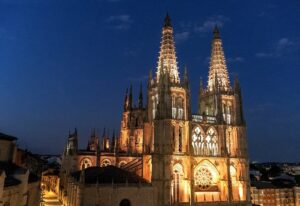If your feet have taken you to Astorga On your magical journey along the Camino de Santiago, you are about to discover a stop that goes beyond being a simple point on the map.
This town, with its cobblestone streets and its historical aura, becomes an essential chapter of your journey. Because? Because every stone of this city breathes the spirit of those who, like you, have searched for something more with every step.
In this corner of León, history intertwines with your path. In the following lines we invite you to explore together the treasures that make Astorga a unique treasure on your trip.
Índice de contenidos
Astorga: An encounter with history and tradition
In the bowels of Astorga, each cobblestone tells a story, and each corner reveals the deep connection of this city with the French Way towards Santiago de Compostela. Here, where the alleys keep centuries-old secrets, you immerse yourself in a narrative that is woven with the threads of time.
Astorga, with its roots dating back to Roman age, is more than a stage; He is a silent witness of countless pilgrimages. The Roman wall, erected in the 3rd century, not only defends the city, but also transports you to a past where the roads were journeys of faith and discovery.
This city becomes an essential chapter of your journey. Astorga is not only a place of passage; It is a historic enclave that has embraced generations of pilgrims, adding layers of meaning to every step you take on your path. It is no coincidence that all organizing company of the Camino de Santiago Choose Astorga as a vital point on the route.
We will now detail the main points of interest.
The Cathedral of Astorga
Before you stands the imposing Cathedral of Santa María de Astorga, an architectural gem that counts for more than just stacked stones. Upon entering, the freshness of the ancient air caresses your senses. The stained glass windows seem like visual murmurs that tell you stories of pilgrims who, like you, sought answers at every step.

In this stone sanctuary, gothic magnificence It is intertwined with the essence of the Camino. Each column is a silent witness to centuries of pilgrimage, and the artistic details reveal a language that goes beyond words.
The Episcopal Palace
Walking in the footsteps of the genius Gaudí, you find yourself in front of the Episcopal Palace of Astorga, a true treasure of art and culture. Its whimsical lines and intricate details they immerse you in a journey where creativity merges with history.
Within its walls, resonating halls house more than art. Each room, decorated with unique pieces, tells the story of a city that has been not only a witness but also a participant in the journey of the Camino de Santiago.
The Roman Wall
The centuries-old stones of the Roman Wall of Astorga keep secrets whispered by the winds of time. Built in the 3rd century, this imposing structure has witnessed the journey of pilgrims who have walked these same paths throughout the centuries.

Walking along its high walls is like leafing through an ancient book full of stories from yesteryear. Each stone, worn by the passage of time, tells stories of faith, resistance and hope. The Roman Wall of Astorga is not only a physical fortification; It is a tangible testament to the connection between this city and the journey of the Camino de Santiago.
Chocolate and local gastronomy
After soaking up the history and culture, your time in Astorga is not complete without a delight for your senses: the famous Astorga Chocolate. Immerse yourself in the charming local shops, where the heady aroma of fresh cocoa welcomes you.
Chocolate here is not simply a delicacy, it is a tradition that has sweetened the steps of countless pilgrims. Each piece of this delicious treasure tells the story of how Astorga, in addition to its monumental heritage, also captivates with its unique flavors.
The nocturnal charm of Astorga
When night falls over Astorga, the city reveals an additional charm that completely transforms your experience. The cobbled streets illuminated by old street lamps They create a magical atmosphere that invites you to explore even more.
The Cathedral, the Episcopal Palace and the Roman Wall they light up differently, as if each stone held additional secrets under the moonlight. Walking through these places after sunset is immersing yourself in a new dimension.

The squares come to life with the nighttime activity of locals and visitors. Local bars and cafes offer you a cozy space to reflect on your journey and share experiences with other pilgrims.
Tips to make your pilgrimage more pleasant
- Invest in footwear that adapts to your feet like a glove.
- Una light backpack It lightens both your physical and mental load, allowing you to enjoy the road more.
- Una water bottle by hand is your ally against fatigue and helps you maintain a constant pace.
- Rest when you need it and adjust your pace based on how you feel. Patience is key on this journey.
- Protect your skin to avoid unnecessary discomfort during your pilgrimage.
- Take time for yourself. Whether sitting in a centuries-old church or contemplating a landscape, those moments of calm add a special touch to your experience.
At each stop, like Astorga, take time to explore. Discover its local treasures, savor the cuisine and absorb the culture to further enrich your journey.
Other Jacobean routes that may interest you
Some pilgrims choose, sometimes due to lack of time or other impediments, to travel alone the last leg, so they decide to do the French road from Sarria to Santiago. Sarria is a Lugo city about 100 km from the capital of Compostela.
On the other hand, if adventure and demanding challenges are your thing, here are three routes that you should consider doing sometime.
- La Northern Route, which runs parallel to the coasts of Cantabria and Asturias, heading west, until reaching Galicia.
- La Portuguese Way route, which begins in Porto (Portugal), heading north.
- El Camino de Santiago from Tui, which takes about 7 to 10 days, leaving from the city of Tui, on the Miño River, in Pontevedra.









